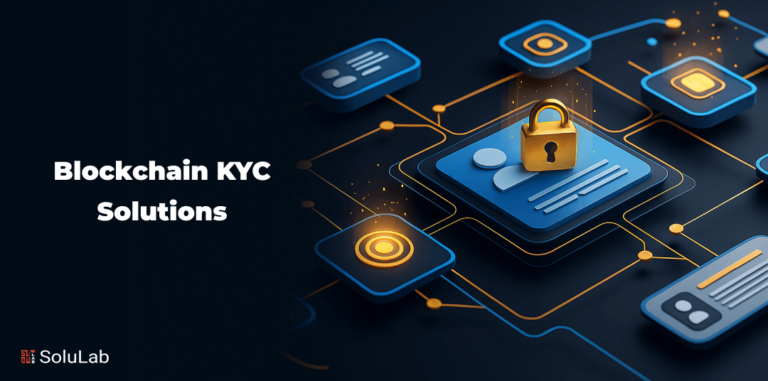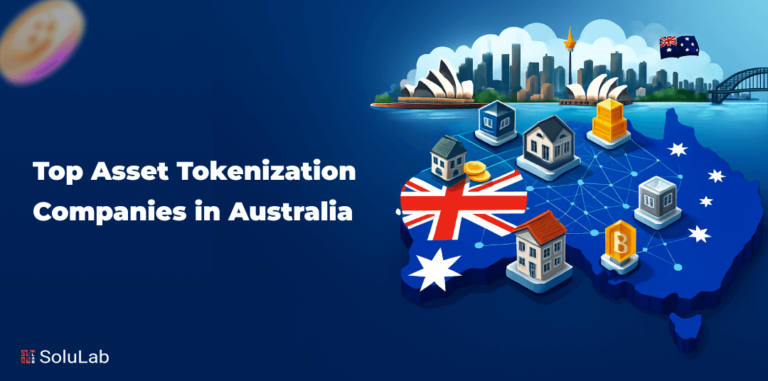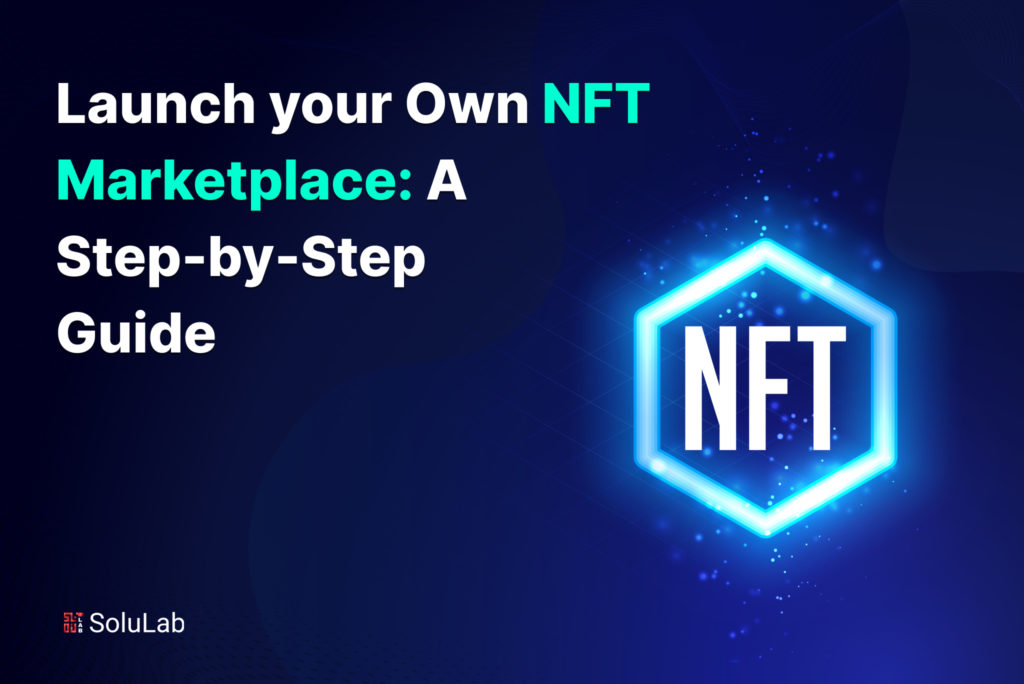
Today, the NFT sector is both a means of self-expression through digital art and a potential financial tool. While having the freedom to come up with anything, NFT artists earn incredible amounts of money, while customers obtain one-of-a-kind goods for resale or collection. However, buying and selling NFTs requires the use of an intermediary. Here, NFT markets come in handy. In this comprehensive guide, we’ll walk you through the steps on how to launch an NFT marketplace and capitalize on this booming market. Before we delve into the nitty-gritty of how you should create your own NFT marketplace, let’s gain a clear understanding of what an NFT marketplace is and why it’s worth your investment of time and effort.
What is an NFT Marketplace?
An NFT (Non-Fungible Token) marketplace is a digital platform where individuals can buy, sell, and trade unique digital assets represented as NFTs. These marketplaces have become the focal point of the booming NFT ecosystem, providing a space for creators, collectors, and investors to engage with digital art, collectibles, virtual real estate, music, videos, and more. If you’re interested in entering this exciting space, you might be wondering how to create your very own NFT marketplace. In this article, we will explore the key aspects of NFT marketplaces, including NFT marketplace development, and guide you through the process of building your own NFT marketplace.
NFT Marketplace Trends
The NFT Marketplace industry is expanding: The Block Research estimates that the overall trading volume of NFTs will exceed $13 billion by 2021. The volume has increased about 400 times from $33 million in 2020.
The data demonstrate that many individuals wish to build and launch an NFT project, leaving room for new platforms to accommodate and exhibit their collections. On an NFT marketplace platform, artists and aficionados want favorable circumstances, convenience, and the possibility to grow and compete. If your marketplace meets their expectations, individuals will pick it as the location for the mint, and you, as the owner, will profit from the launch, sales, and marketing.
Based on this, we may conclude that launching an NFT marketplace now is a promising concept.
The burgeoning NFT marketplace development sector provides several chances for professionals to participate in the design and trading of NFTs. Today, blockchain technology ensures the protection of consumers’ digital assets, hence increasing interest and confidence. Furthermore, storing your tokens in a contemporary crypto wallet makes them more secure and dependable. This is why NFT platform developers may successfully and financially provide in-demand solutions for designing, issuing, and exchanging non-fungible tokens.
What Types of NFT Marketplace are Out There?
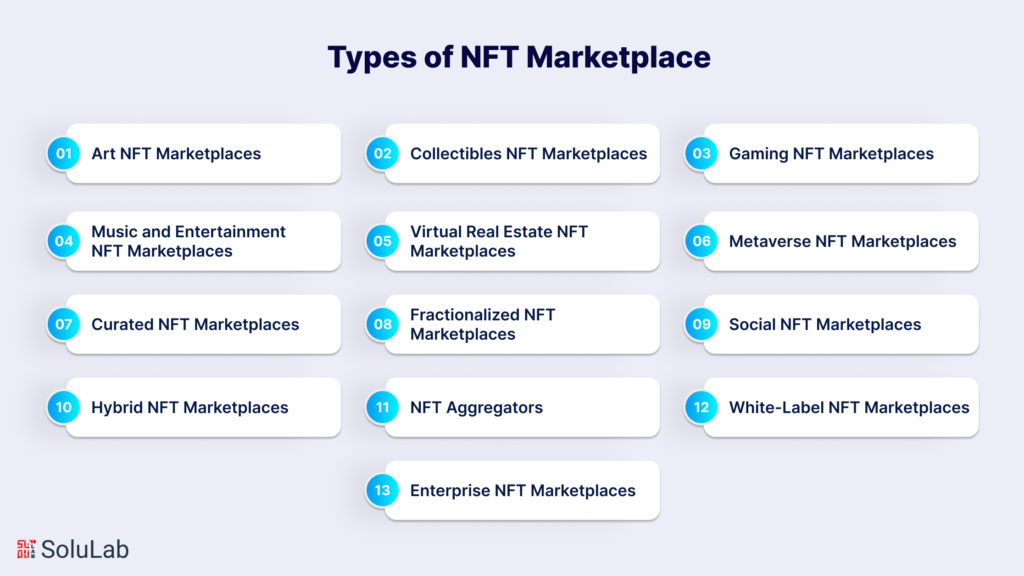
The NFT (Non-Fungible Token) marketplace space has seen significant growth and diversification, offering a range of options to cater to various interests and niches. Here are some types of NFT marketplaces that have emerged:
- Art NFT Marketplaces: These platforms focus primarily on digital art NFTs, allowing artists to showcase and sell their digital creations. Examples include SuperRare, Rarible, and Foundation.
- Collectibles NFT Marketplaces: These marketplaces specialize in digital collectibles, such as virtual trading cards, toys, and in-game items. Notable platforms include NBA Top Shot and CryptoKitties.
- Gaming NFT Marketplaces: Designed for gamers and game developers, these marketplaces enable the creation and trade of in-game assets as NFTs. Decentraland’s marketplace is an example of this category.
- Music and Entertainment NFT Marketplaces: These platforms cater to musicians, filmmakers, and content creators, allowing them to tokenize their work as NFTs. Audius and Mintable are popular in this space.
Read Our Blog: How to Build an NFT Marketplace from Scratch
- Virtual Real Estate NFT Marketplaces: These marketplaces specialize in virtual land and property, where users can buy, sell, and develop virtual real estate assets. Decentraland and The Sandbox are notable examples.
- Metaverse NFT Marketplaces: Metaverse-focused platforms aim to create a unified virtual world where users can buy, sell, and trade NFTs related to their virtual avatars, items, and experiences. The Central and marketplace is a prime example.
- Curated NFT Marketplaces: These platforms curate and offer a selection of high-quality NFTs, often with a focus on exclusivity and limited editions. CryptoArtPulse is one such platform.
- Fractionalized NFT Marketplaces: These marketplaces allow users to buy fractions or shares of high-value NFTs, making ownership more accessible. Fractional is a platform in this category.
- Social NFT Marketplaces: Social NFT platforms integrate social networking features, enabling users to connect, follow, and interact with creators. Zora is an example.
- Hybrid NFT Marketplaces: Some platforms offer a combination of various NFT types, providing a broad spectrum of digital assets for users. OpenSea is a versatile marketplace that supports multiple NFT categories.
- NFT Aggregators: These platforms aggregate NFT listings from various marketplaces, making it easier for users to discover and track NFTs across different platforms. NFTBank and NFTList are examples.
- White-Label NFT Marketplaces: These are customizable marketplace solutions that can be branded and tailored to specific niches or purposes. They provide a quick way to launch an NFT marketplace with less development effort.
- Enterprise NFT Marketplaces: Aimed at businesses and enterprises, these platforms facilitate the creation and management of NFT use cases, including digital assets and certificates.
Why Create NFT Marketplace?
Creating your own NFT (Non-Fungible Token) marketplace can be a strategic decision for various reasons, depending on your goals and motivations. Here are some reasons why you might want to create your own NFT marketplace:
1. Revenue Generation: Running an NFT marketplace can be a lucrative endeavor. You can earn money through transaction fees, listing fees, and by offering premium services to users.
2. Control and Customization: By creating your own NFT marketplace, you have full control over its design, features, and policies. This allows you to cater to a specific niche or audience.
3. Community Building: A well-executed NFT marketplace can foster a thriving community of artists, collectors, and enthusiasts. This community can be an invaluable asset for your brand.
4. Diversification: Diversifying your crypto portfolio can mitigate risks. Owning an NFT marketplace can complement other crypto ventures you may have.
How Do NFT Marketplaces Work?
Before we get started on the whirlwind roller coaster of creating an application for an NFT marketplace, let’s first grasp how it works.
Every NFT marketplace typically follows a similar methodology. Users create and install digital wallets to store NFTs.
Here’s an outline of a few actions you should take after joining up:
- Build an NFT and define all the necessary settings.
- Then, make a list of the digital artworks and other items you wish to present for sale and wait until moderation is complete.
- During auctions, purchasers will bid on your digital items.
- After the auctions are completed successfully, the NFT marketplace sends the sold digital items and cryptocurrencies.
A Step-by-Step Guide to Launch Your Own NFT Marketplace
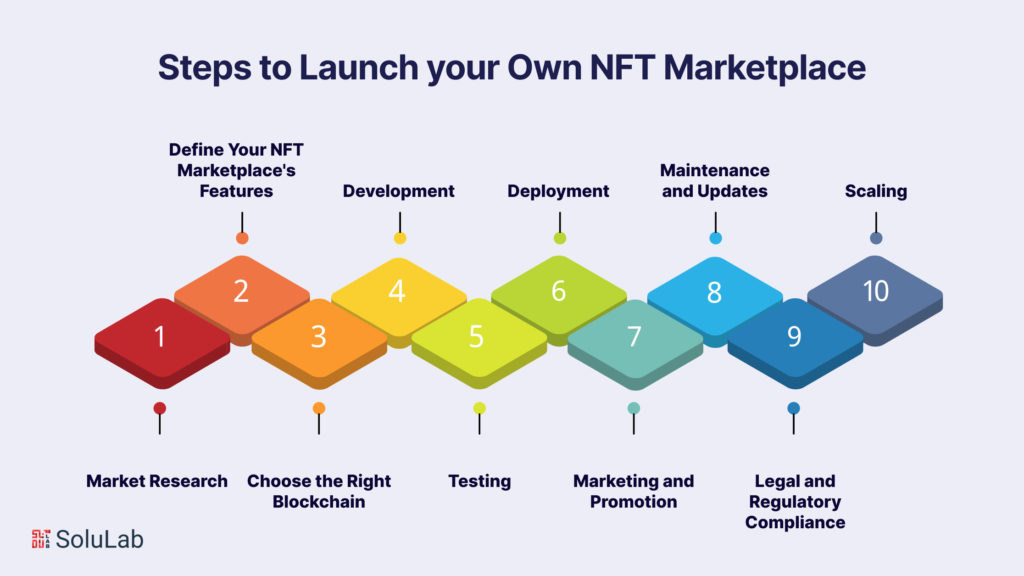
Now that we understand the benefits, let’s dive into the step-by-step process of how to build an NFT marketplace.
Step 1: Market Research
The first and arguably most crucial step in launching your NFT marketplace is conducting thorough market research. Here are some key aspects to consider:
- Identify Your Niche: Determine the focus of your marketplace. Will it cater to artists, gamers, or a specific industry? Knowing your niche will help you tailor your platform to meet their needs.
- Competitor Analysis: Study existing NFT marketplaces to understand their strengths and weaknesses. This will give an idea as to what and what not to implement in your own product.
- Regulatory Compliance: Keep abreast of the legal and regulatory requirements in your jurisdiction related to cryptocurrencies and NFTs. Ensure that your platform complies with these regulations.
- User Demographics: Analyze the demographics of potential users to create a user-friendly platform that resonates with your target audience.
Step 2: Define Your NFT Marketplace’s Features
Once you have a clear understanding of your market, it’s time to define the features and functionalities of your NFT marketplace.
- User Registration and Profiles: This allows users to create accounts, customize their profiles, and manage their collections.
- Wallet Integration: Integrate cryptocurrency wallets to enable users to store and manage their NFTs securely.
- NFT Minting: Provide a user-friendly minting process for creators to tokenize their digital assets and list them for sale.
- Search and Discovery: Implement robust search and filter options, enabling users to easily find NFTs of interest.
- Auction and Fixed Price Listings: Offer both auction-style and fixed-price listings to accommodate different selling strategies.
- Payment Gateway: Integrate payment gateways for seamless cryptocurrency transactions.
- Smart Contracts: Utilize blockchain smart contracts to automate transactions and ensure transparency.
- Security Measures: Prioritize security to protect user data and assets from potential threats.
- Community Tools: Build features for user engagement, such as forums, chat, and social sharing.
- Analytics and Reporting: Provide users with insights into their transactions and collections.
Step 3: Choose the Right Blockchain
The choice of blockchain is pivotal to your NFT marketplace’s success. Ethereum is the most popular choice due to its established NFT standards (ERC-721 and ERC-1155). Other blockchains, such as Flow and Binance Smart Chain, are, nonetheless, gaining popularity.
Step 4: Development
NFT marketplace development will require technical expertise. You have several options:
- In-House Development: If you have a skilled development team, you can choose to build the marketplace from scratch. This offers the most customization but may be the most time-consuming and expensive option.
- Use NFT Marketplace Development Services: Many development firms specialize in creating NFT marketplaces. They can streamline the development process and offer pre-built solutions that can be customized to your needs.
- White-Label Solutions: Some companies offer White-Label NFT marketplace, which are ready-made platforms that you can brand and customize as your own. This path to market is more expedient.
Step 5: Testing
Before launching your NFT marketplace to the public, rigorous testing is essential. Check the usability, security, and operation of the platform. Engage a group of beta testers to provide feedback and identify any issues.
Step 6: Deployment
Once your marketplace passes all tests and is ready for prime time, deploy it to the blockchain of your choice. This involves configuring smart contracts, setting up servers, and ensuring that the platform is live and accessible.
Read Our Blog: How to Build an NFT Marketplace on Ethereum Blockchain?
Step 7: Marketing and Promotion
Building the marketplace is only half the battle; the other half is getting users to join and transact. Here are some strategies for marketing your NFT marketplace:
- Social Media: Leverage platforms like Twitter, Instagram, and TikTok to create a buzz around your marketplace. Engage with influencers and artists in the NFT space.
- Content Marketing: Start a blog or YouTube channel that covers NFT trends, artist profiles, and marketplace updates.
- Partnerships: Collaborate with artists, creators, and other NFT-related projects for cross-promotion.
- Community Building: Foster a strong community on your platform through engagement, contests, and rewards.
- Email Marketing: Build an email list and send out newsletters with updates and promotions.
- Paid Advertising: Invest in targeted advertising on platforms like Google and Facebook.
Step 8: Maintenance and Updates
Launching your NFT marketplace is just the beginning. Regularly update the platform to improve user experience and security. Listen to user feedback and adapt to the evolving NFT landscape.
Step 9: Legal and Regulatory Compliance
As the owner of an NFT marketplace, it’s crucial to stay compliant with the ever-changing legal and regulatory environment. This includes tax compliance, data protection, and any new regulations specific to NFTs.
Step 10: Scaling
As your NFT marketplace grows, consider scaling options. This may involve adding new features, expanding to other blockchains, or exploring partnerships to reach a wider audience.
Key Considerations for NFT Marketplace Development
When you understand how to create an NFT marketplace, there are a few fundamental requirements to follow. In short, your platform should be safe, transparent, and decentralized.
When it comes to the safety of marketplace components, you should use cloud security solutions that can help you safeguard your confidential information.
When we talk about transparency, we emphasize that the payment process needs to be error-free and prevent any unanticipated problems. Blockchain technology can help you operate your cryptocurrency transactions more smoothly. With this technology, you will get a detailed view of every transaction that occurs on your NFT platform.
Conclusion
Creating your own NFT marketplace is a challenging yet rewarding endeavor. With the right research, planning, and execution, you can tap into the booming NFT market and build a thriving platform that caters to artists, collectors, and enthusiasts. Remember that success in the NFT space requires continuous innovation, community engagement, and adaptability to emerging trends and technologies. So, start your journey towards launching your own NFT marketplace today and be part of this exciting digital revolution.
Get in touch with SoluLab to get started with the help of our expert NFT developers if you want your entry into the trendy NFT field to be simple. Our NFT Marketplace Development services will help you assess your project idea, provide advice on the best tech stack, and construct a strong, secure, and feature-rich NFT platform that will provide you the freedom to exploit numerous possibilities and maintain an edge in the NFT space. Contact SoluLab today to enter the world of NFTs and excel right from the first day!
FAQs
1. What is an NFT Marketplace?
NFTs are unique digital assets that represent ownership or proof of authenticity of digital or physical items, making them valuable in various industries, including art, gaming, entertainment, and more.
2. What are NFTs?
NFTs, or Non-Fungible Tokens, are digital tokens that are indivisible and cannot be exchanged on a one-to-one basis like cryptocurrencies such as Bitcoin or Ethereum. Each NFT is one-of-a-kind and represents ownership of a specific digital item, whether it’s digital art, music, collectibles, virtual real estate, or any other unique digital content.
3. How do I use an NFT Marketplace?
To use an NFT Marketplace, you typically need a cryptocurrency wallet and some knowledge of how NFT transactions work. You can create an account on the marketplace, browse listings, make purchases, and manage your NFT collection. Make sure to read the platform’s terms of service and user guidelines for a smooth experience.
4. Can I sell my own digital content on an NFT Marketplace?
Absolutely! NFT marketplaces allow creators to mint their digital content into NFTs and list them for sale. You can tokenize your art, music, videos, or any other unique digital creation. Just follow the platform’s guidelines for minting and listing NFTs.
5. How do NFT transactions work?
NFT transactions are typically conducted using cryptocurrency, often Ethereum (ETH). When you purchase an NFT, you’ll send the required amount of cryptocurrency to the seller’s wallet address in exchange for ownership of the NFT. Blockchain smart contracts ensure the security and authenticity of the transaction.
6. Are NFTs only for digital art?
No, NFTs have a wide range of use cases beyond digital art. While art is a popular category, NFTs can represent various digital or physical assets, including music, collectibles, virtual real estate, in-game items, domain names, and more. The NFT ecosystem continues to expand into new industries and applications.





